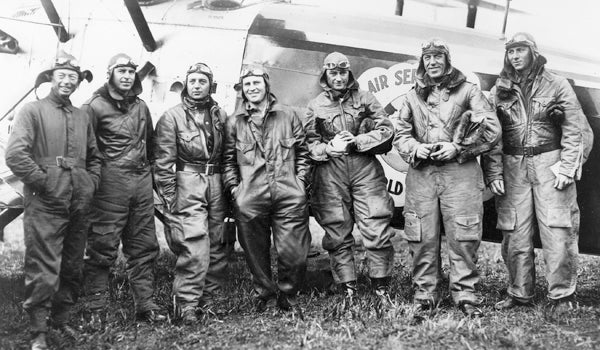Around the world adventure, part two
Published 10:02 am Thursday, July 14, 2016

- The Magellans of the Air pose for a picture just before taking off from Seattle in April 1924. Leigh Wade is in the center of the photo. (Photo courtesy of the Dowagiac Area History Museum)
From the moment four American pilots took off from Seattle in April 1924 on their mission to be the first pilots to fly across the globe, they encountered problems. Leigh Wade of Cassopolis piloted one of the four planes, “The Boston,” as the team worked their way north toward Alaska and the Aleutian Islands. One plane did not even make it off the continent.
The commanding pilot, Maj. Frederick Martin, had an engine explode and he made an emergency landing.
“It took the Navy three days to find them, several more to install a new engine,” Wade said. “Then they took off to catch up with us in Dutch Harbor. They never got there.”
Martin encountered a severe storm and flew into a snow-covered mountain. Amazingly, both he and his mechanic survived the crash. They set off on foot in search of any sign of civilization. They wandered the arctic wilderness for a week before finding a remote outpost with basic provisions to help them survive. The other pilots left on May 2 without their commander.
The entire flight was a significant world event. The Dowagiac Daily News had regular progress reports of not just the American flyers, but of the international teams also racing to be the first to accomplish the feat.
While the American pilots waited almost a week for Maj. Martin in Dutch Harbor, the British team arrived in Baghdad, Iraq, and then blew out an engine in the “Chad” Desert.
By May 17, 1924, the three surviving American planes had made it to Japan, which completed the “longest jump” of the flight. According to the Daily News report, they were to continue onto Tokyo, where the military overhauled and fixed
the airplanes.
The pilots quickly made their way to mainland China and Indo-China (today Vietnam) while encountering more mechanical problems with planes — specifically Lowell Smith’s plane.
After plenty of problems in the first couple of months of the voyage, the three remaining planes began to run more reliably as they made their way over Asia and to Constantinople. The July 11 report said, “The American World flight effort is proceeding swiftly and smoothly, step by step without a hitch and [the pilots] will be in Europe on their next hop.”
The trip across Europe was a quick one as they arrived in Paris on July 14. After a grand celebration in Paris, the pilots set off for London to prepare for the treacherous flight across the Atlantic Ocean. The flight across Europe was so fast they were delayed a few days because the U.S. Navy did not have its ships in place to aid the flyers in the Atlantic.
On Aug. 4, the oil pump on Leigh Wade’s plane failed and he had to land on the water. They attempted to repair it on the water, but they could not do it.
“It’s a nasty business, bobbing up and down in 20-foot-high waves,” Wade said. “The plane could break apart at any minute. Odgen and I were scared and miserable, cold and seasick.”
The Navy recovered the pilots and the plane, but eventually found the waters too rough and they had to cut the plane loose. It appeared that Wade’s historic flight was done. The British flight ended in the Bering Sea on the same day.
A new Douglas plane, “The Boston II,” was ordered for Wade in Nova Scotia and he rejoined the race. The three planes arrived in Boston on Sept. 6 to great fanfare. “Riotous receptions marked every landing as we zig-zagged our way back to Seattle,” Wade said. “In Los Angeles…the crowd cracked two of my ribs in the crush.” The three Douglas planes arrived in Seattle on Sept. 18, completing the first Around-the-World-Flight in 175 days. They flew 26,345 miles in 371 hours — usually flying under 1,000 feet — at an average rate of 72 mph.
The flight was historic and emotions were mixed for Wade. He wrote that he felt “nervous and physical strain, a lifetime of extraordinary sights and scenes, memorable meetings, moments of terror, high elation, six months of never-to-be-forgotten adventure.”
The pilots were celebrities across the country.
Leigh Wade got an endorsement deal from Packard automobiles to drive a Packard across the country without once allowing the car or motor to come to a stop. Wade made the trip in seven days.
He left the air service in 1926, but returned during World War II. He retired from the Air Force in 1955 as a Major General. Leigh Wade, Cass County’s first aviation pioneer, passed away at the age of 94 in 1991.
Steve Arseneau is the director of the Dowagiac Area History Museum. He resides in Niles with his wife, Christina, and children, Theodore and Eleanor.





